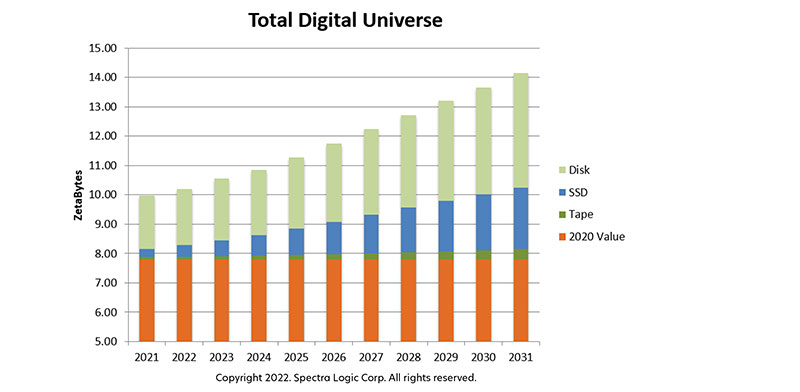Spectra’s new Data Storage Outlook report explores how organisations manage and preserve growing data repositories, from cloud capabilities to energy consumption to IT security.

Spectra Logic has released its seventh Data Storage Outlook report, a comprehensive annual report that explores how organisations are managing, accessing, using and preserving growing data repositories. Serving as a planning resource for IT developers, it also looks into the strategies and systems designed with the critical role of protecting the data being created now and in the future.
“Supply shortages, cybercrime and extreme data creation rates have sparked a commitment to advances in data storage and new distributed cloud interoperability,” said Spectra Logic Senior Director of Emerging Markets David Trachy. “These developments will serve as the foundation of future storage, preservation, management and usage of the world’s information.”
This new edition of the Data Storage Outlook report examines the equipment and techniques defining the long-term storage landscape today including persistent memory, flash, magnetic disk, tape, optical, cloud and future storage innovation.
Major topics explored within the 2022 report include Flash storage such as PCIe Gen 5 products, which are in early stages of announcement and indicate speeds that exceed 10 GB/s. Among the innovations in this area are the utilisation of flash inside disk systems to improve capacity and performance.

Regarding tape developments, LTO-9 tape is now shipping with a capacity point of 18TB per cartridge, a 50% capacity increase over LTO-8. Also, some tape vendors are now shipping systems that support the AWS S3 Glacier storage interface, perhaps creating a potential for new cost-effective possibilities between tape and cloud that mitigate the impact of monthly cloud storage charges.
The report considers that more products are likely to appear that are designed with the cloud in mind, capable of supporting complex workflows. These systems aim to support direct integration of applications into storage infrastructure regardless of storage location – whether in the cloud, multiple clouds or in multiple on-premises locations. Cloud providers are also expected to control, in terms of both volume and revenue, a larger portion of the storage required to support the digital universe.
End users may no longer have to think about the underlying storage system used in a cloud environment, but be able to focus on setting policies that allow the automatic movement of data to the right locations, to the right storage tiers, at the right time, with the freedom to decide which processes they want to run locally, and which ones in the cloud.
Spectra’s report also considers the likelihood of greater focus on electrical energy consumption generated from non-renewable energy sources because of growing global warming concerns. As the demand for information technology is predicted to grow extremely rapidly over the next decade, the challenge will be how to satisfy this demand while at the same time attempting to decrease the associated CO2 emissions.
Spectra Logic’s complete ‘2022 Data Storage Outlook’ report can be downloaded here. spectralogic.com



